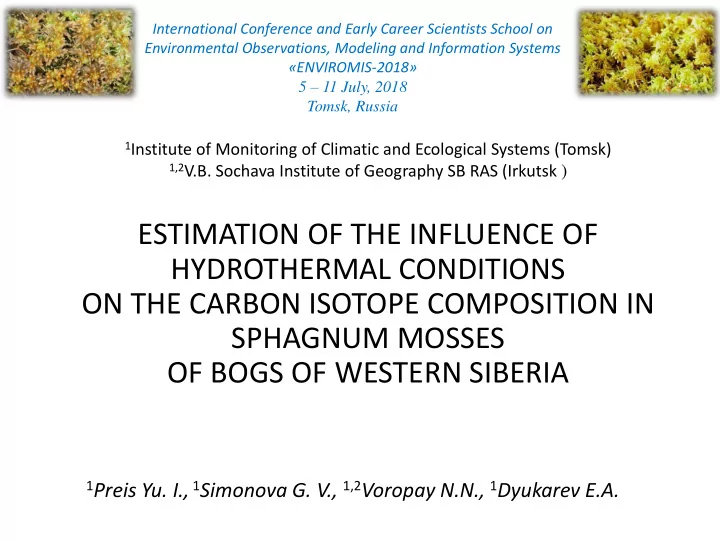

International Conference and Early Career Scientists School on Environmental Observations, Modeling and Information Systems « ENVIROMIS-2018 » 5 – 11 July, 2018 Tomsk, Russia 1 Institute of Monitoring of Climatic and Ecological Systems (Tomsk) 1,2 V.B. Sochava Institute of Geography SB RAS (Irkutsk ) ESTIMATION OF THE INFLUENCE OF HYDROTHERMAL CONDITIONS ON THE CARBON ISOTOPE COMPOSITION IN SPHAGNUM MOSSES OF BOGS OF WESTERN SIBERIA 1 Preis Yu. I., 1 Simonova G. V., 1,2 Voropay N.N., 1 Dyukarev E.A.
is estimation of the influence of hydrothermal conditions on the carbon isotope composition in sphagnum mosses of bogs of Western Siberia Sphagnum mosses samples from oligotrophic bogs of Western Siberia along the meridian transect from the tundra to the forest-steppe were collected from 176 sites of 40 bogs. Sampling sites map 2
Samples preparation: 1. Processing by HCl 3% for carbonates removing. 2. Washing out by deionized water in ultrasonic bath. 3. Drying at 70 ˚С during 24 hrs. 4 2 The determination of δ13C in 3 moss samples was carried out 6 using the standard method 5 using the Flash 2000 element analyzer and the DELTA V 1 Advantage isotope mass spectrometer at the Tomsk 1. Isotope mass spectrometer DELTA V Advantage for Center for Equipment Sharing determining isotope ratios (IRMS) company Thermo of the SB RAS. Fisher Scientific, Germany; 2. Elemental analyzer Flash 2000 (EA); The isotopic composition was 3. Gas chromatograph TRACE GC ULTRA interface measured with respect to the GC IsoLink (GC); standard gas calibrated 4. GasBench II - a system study of carbonates and according to the cellulose water samples; standard IAEA-CH-3 (IAEA). 5. Quadrupole mass spectrometer; The error of the 6. System timing ConFlowIV. measurement result did not exceed ± 0.2 ‰ . 3
Group of Group of S. balticum S. fuscum (aero- and (mesohydrophytes*) subhydrophytes S. balticum S. fuscum S. majus S. rubellum S. fallax S. capillifolium S. riparium S. fimbriatum Samples of each group were divided into those selected on habitats with typical and notypical (adverse water regimes). 4 * Lapshina E.D. Flora of the bogs of the southeast of Western Siberia. 2003, 296 p.
typical water regime all sites S. balticum - 23.1… -30.7 ‰ - 23.02… -27.7 ‰ all sites typical water regime S. fuscum - 25.5… -31.6 ‰ - 27… -29.6 ‰ Median values δ 13 С and standard deviations for groups of mosses 5
Correlation coefficients between 13С and weather parameters (2010-2013) S. balticum S. fuscum Habitats Non Non All Typical All Typical Weather typical typical parameters Tveg 0.00 0.01 -0.50 -0.09 -0.18 -0.16 Ts10 -0.04 -0.01 -0.51 -0.12 -0.19 -0.21 Pyr 0.55 0.12 0.48 0.30 0.36 0.28 Pveg 0.65 0.39 0.41 0.21 0.25 0.20 Psum 0.52 0.38 0.35 0.18 0.31 0.08 Pwin 0.40 -0.05 0.36 0.30 0.31 0.28 Tyr – annual air temperature; Tveg – May-Sep air temperature; Tsum – Jun-Aug air tempearture; Ts10 – sum temperature above 10 oC; Pyr – annual precipitations; Psum – summer precipitations (Jun-Aug); Ps10 – precipitations at air temperature above 10 oC; Pwin – winter precipitations (Dec-Feb). 6
Correlations of mean 13С contents with Selyaninov Hydrothermal coefficient (HTC) S. balticum S. fuscum Sites Non Non All Typical All Typical typical typical HTC 2010-2013 0.58 0.27 0.79 0.45 0.53 0.21 HTC 2000-2016 0.63 0.26 0.36 0.31 0.37 0.28 HTC 1985-2016 0.66 0.23 0.46 0.36 0.34 0.40 HTC ( ГТК Селянинова ) = 10*Ps10 / Ts10 Positive correlations of C13 were found for the hydrothermal coefficient averaged for 2010-2013 : for the S. balticum mosses from all and from non typical habitats, and for the S. fuscum mosses from typical habitats. 7
Sph. balticum Sph. fuscum HTC HTC Correlations of mean δ 13 C with HTC (2010-2013). Sites: all – blue, typical – red, non typical – green. δ 13 C = a + b × HTC 8
Multiply linear regression model 13 С = a + b × Ts10 + c × HTC + d × Pwin Sph. Balticum Sph. Fuscum All Typical Non Typical All Typical Non Typical a ( ) -25.56 -23.14 -28.81 -28.80 -28.30 -28.70 b (Ts10) -0.0065 -0.0026 -0.0024 -0.0013 -0.0011 -0.0024 c (HTC) 0.0599 0.0234 0.0142 0.0098 0.0083 0.0185 d (Pwin) -0.0618 -0.0900 0.0205 0.0154 0.0099 -0.0301 Std Err 1.38 1.11 0.85 0.83 0.49 0.50 r 0.76 0.51 0.68 0.33 0.43 0.64 A multiple linear regression model in which the sum of temperatures above 10 ° C, the hydrothermal coefficient and the sum of the precipitation of the winter period are used as predictors, makes it possible to explain from 26 to 58% (r = 0.51 ÷ 0.76) the observed variability of δ13C for all mosses and habitats, except the S. fuscum mosses from all habitats. 9
Conclusions The absence or weak correlation of the δ13C composition of sphagnum mosses, both hydrophytes and mesohydrophites, of typical habitats with meteorological parameters indicates the azonal character of the vegetation of oligotrophic bogs of the West Siberian Plain and confirms the determining influence of local factors on δ13C composition of Sphagnum mosses. Zonal features of δ13С are manifested only in mosses of S. balticum group from habitats with non typical water regimes. The presence of links with precipitation confirms the significant effect of the moisture regime on δ13C mosses of the Sphagnum balticum group. Extremely sensitive response to changes in local conditions of growth of hydrophytic sphagnum mosses confirms the possibility of using them for monitoring the functional state of wetlands and climate changes. This work was supported by RFBR (grants No. 16-45-700941 and No. 17-05-00860/17). 10
11
Recommend
More recommend